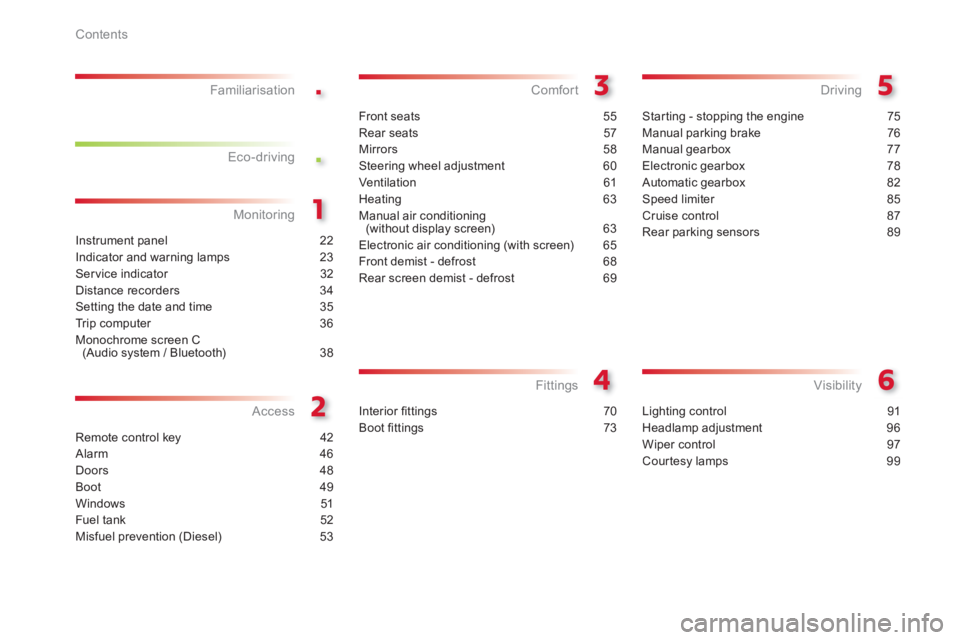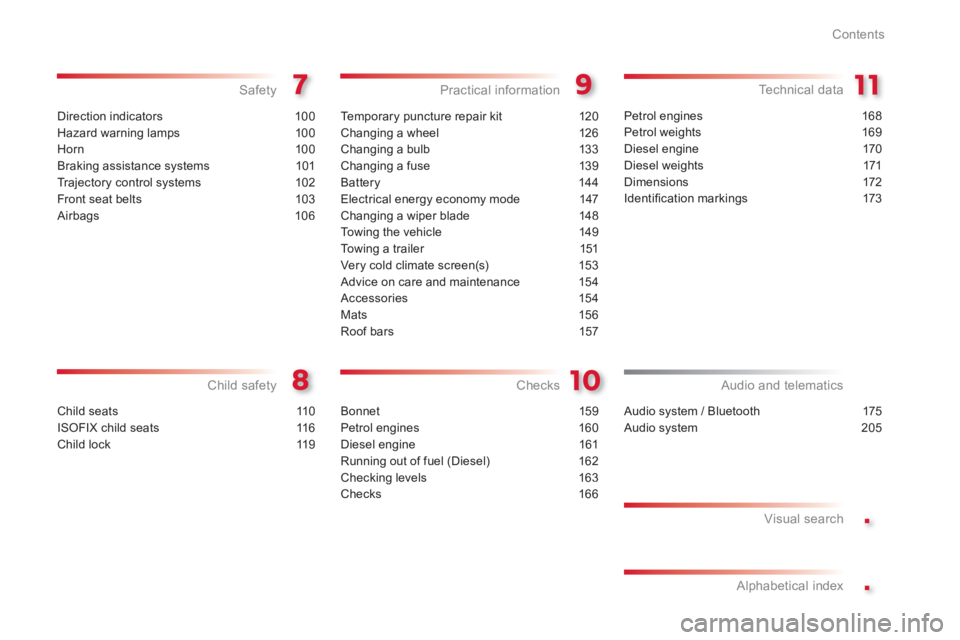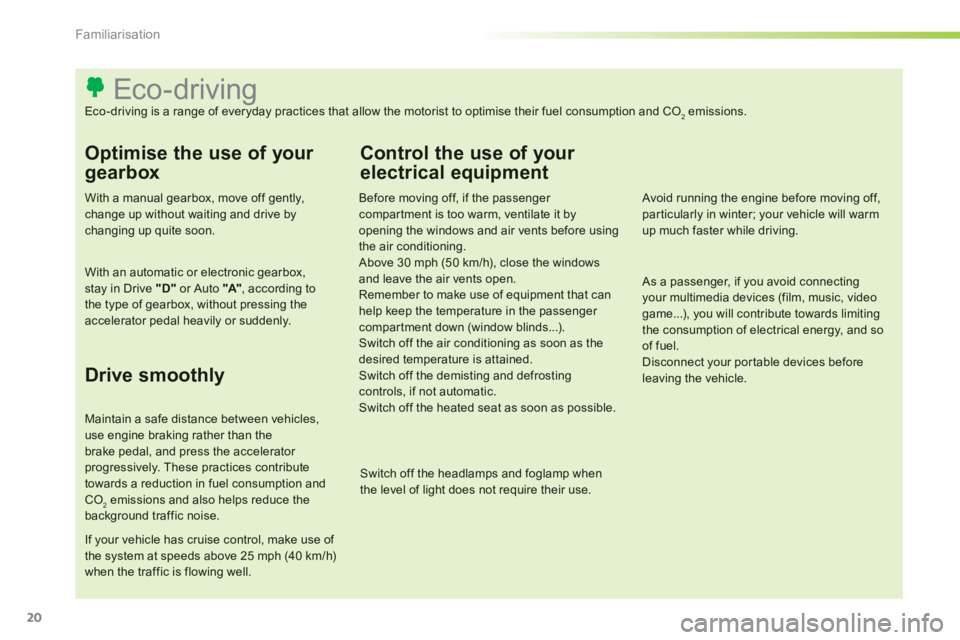engine CITROEN C-ELYSÉE 2012 Owners Manual
[x] Cancel search | Manufacturer: CITROEN, Model Year: 2012, Model line: C-ELYSÉE, Model: CITROEN C-ELYSÉE 2012Pages: 236, PDF Size: 5.92 MB
Page 4 of 236

.
.
Contents
Instrument panel 22
Indicator and warning lamps 23
Ser vice indicator 32
Distance recorders 34
Setting the date and time 35
Tr i p c o m p u t e r 36
Monochrome screen C(Audio system / Bluetooth) 38
Monitoring Familiarisation
Remote control key 42
Alarm 46
Doors 48
Boot 49
Windows 51
Fuel tank 52
Misfuel prevention (Diesel) 53
Access
Front seats 55
Rear seats 57
Mirrors 58
Steering wheel adjustment 60
Ventilation 61
Heating 63
Manual air conditioning(without display screen) 63
Electronic air conditioning (with screen) 65
Front demist - defrost 68
Rear screen demist - defrost 69
Comfort
Starting - stopping the engine 75
Manual parking brake 76
Manual gearbox 77
Electronic gearbox 78
Automatic gearbox 82
Speed limiter 85
Cruise control 87
Rear parking sensors 89
Driving
Lighting control 91
Headlamp adjustment 96
Wiper control 97
Courtesy lamps 99
Visibility Eco-driving
Interior fi ttings 70
Boot fi ttings 73
Fittings
Page 5 of 236

.
.
Contents
Direction indicators 100
Hazard warning lamps 100
Horn 100
Braking assistance systems 101
Tr ajectory control systems 102
Front seat belts 103
Airbags 106
Safety
Child seats 110
ISOFIX child seats 116
Child lock 119
Child safety
Te m p o r a ry puncture repair kit 120
Changing a wheel 126
Changing a bulb 133
Changing a fuse 139
Battery 144
Electrical energy economy mode 147
Changing a wiper blade 148
To w i ng the vehicle 149
To w i ng a trailer 151
Very cold climate screen(s) 153
Advice on care and maintenance 154
Accessories 154
Mats 156
Roof bars 157
Practical information
Petrol engines 168
Petrol weights 169
Diesel engine 170
Diesel weights 171
Dimensions 172
Identifi cation markings 173
Technical data
Audio system / Bluetooth 175
Audio system 205
Audio and telematics
Visual search
Alphabetical index Checks
Bonnet 159
Petrol engines 160
Diesel engine 161
Running out of fuel (Diesel) 162
Checking levels 163
Checks 166
Page 17 of 236

.
15
Familiarisation
Monitoring
A.With the ignition on, the bars representingthe fuel level should come on. B.With the engine running, the associated
low level warning lamp should go off.
Instrument panel
With the ignition on, the orange and red warning lamps come on.
With the engine running, these warning lamps
should go off.
If a warning lamp remains on, refer to the pageconcerned.
Warning lamps
23-3122
Illumination of the lamp indicates the status of
the corresponding function.
Switch panel
102
A.Deactivation of the ESP/ASR system.
49
B.Opening the boot (depending on version).
C.Alarm warning lamp.
46
Page 19 of 236

.
17
Familiarisation
Driving safely
Electronic gearbox
Five-speed electronically controlled gearbox
offering the choice of the comfor t of automated
operation or the pleasure of manual gear changing.1. Gear lever.
Display in the instrument panel
The gear engaged or the driving mode selected appears in the instrument panel screen. N.Neutral.R.
Reverse.
1 to 5. Gears engaged. AUTO.Automated mode.
Moving off
�)
Select position N.�)
Press firmly on the brake pedal. �)
Start the engine.�)
Select the automated mode (position A
) Aor manual mode (position M ) by moving
the gear lever 1,
or
engage reverse by pushing the gear
lever 1 to position R . �)
Release the parking brake. �)
Progressively take your foot off the brake
pedal: the vehicle moves off.
7
8
Page 20 of 236

18
Familiarisation
82
Driving safely
Automatic gearbox
Four-speed gearbox offering the choice of the comfor t of automatic operation or the pleasure
of manual gear changing.1. Gear lever.2."S"
(sport) button.3."�7"
(snow) button.
Display in the instrument panel
The gear engaged or the driving mode selected
appears in the instrument panel screen.P.Park. R. Reverse.
N.Neutral.D.Drive (automatic forward drive).
S.Sport programme. �7Snow
programme.
1 to 4. Gears engaged.-.
Invalid value in manual operation.
Moving off
�)Apply the parking brake. �)Select position P
or N.�)Start the engine.�)Press the brake pedal. �)Release the parking brake. �)Then select position R
, D
or M
. �)Progressively take your foot off the brake pedal: the vehicle moves off.
Page 21 of 236

.
19
Familiarisation
Driving safely
1.
Selection of limiter mode. 2.Reducing the programmed value. 3.Increasing the programmed value. 4.
Limiter On / Off.
Speed limiter "LIMIT"
85
1.Selection of cruise control mode.
2. Reducing the programmed value.3.
Increasing the programmed value.4.
Cruise control On / Off.
Cruise control "CRUISE"
87 The cruise control or speed limiter mode
appears in the instrument panel when selected.
Display in the instrument
panel
Cruise control
S
peed limiter
The settings must be made with the engine running.To be programmed or activated, the speed of
the vehicle must be above 25 mph (40 km/h),with at least 4thengaged for a manual gearbox (2 nd for an electronically controlled or automatic gearbox).
Page 22 of 236

20
Familiarisation
Eco-driving
Eco-driving is a range of everyday practices that allow the motorist to optimise their fuel consumption and CO2emissions.
Optimise the use of your
gearbox
With a manual gearbox, move off gently,change up without waiting and drive by changing up quite soon.
With an automatic or electronic gearbox, stay in Drive "D"or Auto "A"
, according to the type of gearbox, without pressing theaccelerator pedal heavily or suddenly.
Drive smoothly
Maintain a safe distance between vehicles, use engine braking rather than the brake pedal, and press the accelerator progressively. These practices contribute towards a reduction in fuel consumption and CO2 emissions and also helps reduce the background traffic noise.
If your vehicle has cruise control, make use of the system at speeds above 25 mph (40 km/h) when the traffic is flowing well.
Control the use of your
electrical equipment
Before moving off, if the passenger compartment is too warm, ventilate it byopening the windows and air vents before using the air conditioning.
Above 30 mph (50 km/h), close the windows and leave the air vents open.
Remember to make use of equipment that canhelp keep the temperature in the passenger compartment down (window blinds...).
Switch off the air conditioning as soon as the desired temperature is attained.
Switch off the demisting and defrostingcontrols, if not automatic. Switch off the heated seat as soon as possible.
Switch off the headlamps and foglamp whenthe level of light does not require their use.
Avoid running the engine before moving off,particularly in winter; your vehicle will warmup much faster while driving.
As a passenger, if you avoid connecting your multimedia devices (film, music, videogame...), you will contribute towards limitingthe consumption of electrical energy, and soof fuel.
Disconnect your por table devices beforeleaving the vehicle.
Page 23 of 236

.
21
Familiarisation
Limit the causes of excess
consumption
Spread loads throughout the vehicle; placethe heaviest items in the bottom of the boot,as close as possible to the rear seats.Limit the loads carried in the vehicle and reduce wind resistance (roof bars, roof rack, bicycle carrier, trailer...). Use a roof box inpreference.Remove roof bars and roof racks after use.
At the end of winter, remove snow tyres and refit your summer tyres.
Observe the recommendations
on maintenance
Check the tyre pressures regularly, when cold, referring to the label in the door aper ture, driver's side.Carry out this check in par ticular:- before a long journey,- at each change of season,- after a long period out of use. Don't forget the spare wheel and the tyres onany trailer or caravan.
Have your vehicle ser viced regularly (engine oil, oil filter, air filter...) and obser ve the
schedule of operations recommended by themanufacturer.
When refuelling, do not continue after the3 rd
cut-off of the nozzle to avoid any over flow.
At the wheel of your new vehicle, it is only after the first 1 800 miles (3 000 kilometres) that you will see the fuel consumption settledown to a consistent average.
Page 25 of 236

1
23
Monitoring
Indicator and warning lamps
Cer tain warning lamps may come onin one of two different modes. Only by relating the type of illumination to the operating status of the vehicle can itbe ascertained whether the situation isnormal or whether a fault has occurred.
When the ignition is switched on
Certain warning lamps come on for a few seconds when the vehicle's ignition isswitched on.
When the engine is started, these same
warning lamps should go off.
If they remain on, before moving off, refer to the
information on the warning lamp concerned.
Associated warnings
The illumination of cer tain warning lamps may be accompanied by an audible signal and a
message in the multifunction screen.
The warning lamps may come on continuously (fixed) or flash.
Visual indicators informin
g the driver that a system is in operation (operation or deactivation indicator lamps) or of the occurrence of a fault(warning lamp).
Page 27 of 236

1
25
Monitoring
Warning / indicator lampStateCauseAction / Observations
Diesel engine pre-heating fixed. The ignition switch is at
the 2nd position (ignition on). Wait until the warning lamp goes off before star ting.
The period of illumination of the warning lamp is
determined by the climatic conditions (up to about
thir ty seconds in extreme climatic conditions).
If the engine does not star t, switch the ignition off and
then on, wait until the warning lamp goes off again,
then start the engine.
Parkingbrake fixed. The parking brake is applied or notproperly released. Release the parking brake to switch off the warninglamp, keeping your foot on the brake pedal.
Obser ve the safety recommendations.
For further information on the parking brake, refer to
the "Driving" section.
Foot on thebrake pedal fixed. The brake pedal must be pressed. With an electronic gearbox, press the brake pedal to start the engine (lever in position N).
With an automatic gearbox, with the engine running,
press the brake pedal before releasing the parking
brake, to unlock the lever and come out of position P . PIf you wish to release the parking brake without pressing the brake pedal, this warning lamp will
remain on.
flashin
g. With an electronic gearbox, if you hold the vehicle on an incline using
the accelerator for too lon
g, the clutchoverheats. Use the brake pedal and/or the parkin
g brake.